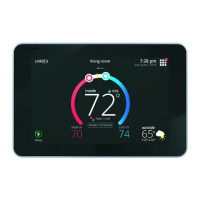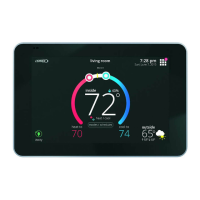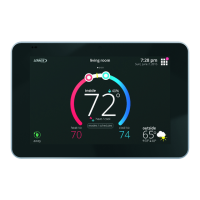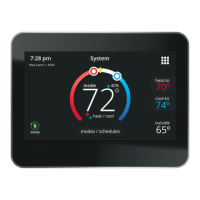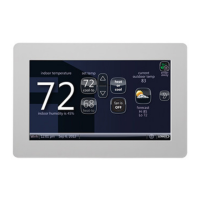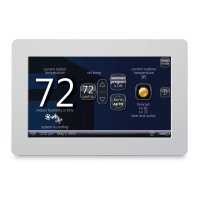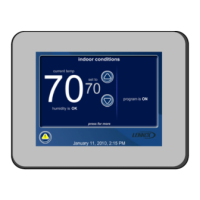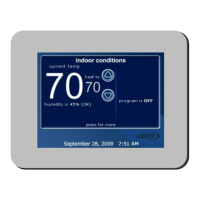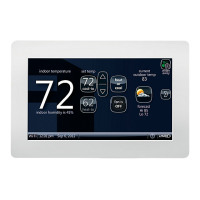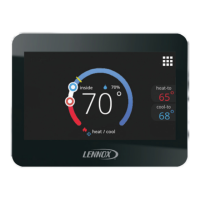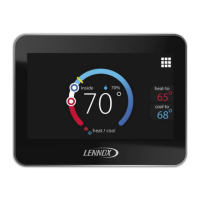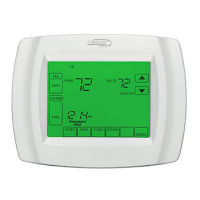How to resolve Lennox iComfort S30 Thermostat displaying 'Failed Flash CRC Check'?
- Aangelica50Sep 8, 2025
To recover from a 'Failed Flash CRC Check' alert code on your Lennox Thermostat, a manual system power reset is required.
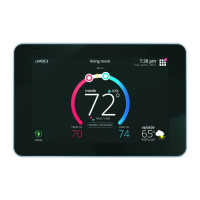
How to resolve Lennox iComfort S30 Thermostat displaying 'Failed Flash CRC Check'?
To recover from a 'Failed Flash CRC Check' alert code on your Lennox Thermostat, a manual system power reset is required.
What to do if Lennox iComfort S30 shows 'Unknown Device Detected - DEVICE2'?
If your Lennox Thermostat displays 'Unknown Device Detected - DEVICE2', go to menu > advance settings > view dealer control center > equipment and press reset all equipment. This will allow the system to auto-detect any iComfort® components attached.
What does 'Low Ambient HP Heat Lockout' mean on Lennox iComfort S30 Thermostat?
The 'Low Ambient HP Heat Lockout' on your Lennox Thermostat is a notification only alert code and will automatically clear once the outdoor temperature rises above the low balance point.
How do I clear 'Asynchronous Reset DEVICE2' on my Lennox iComfort S30 Thermostat?
To clear the 'Asynchronous Reset DEVICE2' alert code on your Lennox Thermostat, go to menu > settings > advanced settings > view dealer control center > notifications, select the alert code, and press the clear button.
What to do if my Lennox iComfort S30 displays 'Missing DEVICE2'?
If your Lennox Thermostat displays 'Missing DEVICE2', cycle system power, and if the problem persists, clear it by reconfiguring the system.
| Connectivity | Wi-Fi |
|---|---|
| Energy Reports | Yes |
| Category | Thermostat |
| Manufacturer | Lennox |
| Model | iComfort S30 |
| Type | Smart Thermostat |
| Humidification Control | Yes |
| Dehumidification Control | Yes |
| Indoor Air Quality Monitoring | Yes |
| Display | Touchscreen color display |
| Compatibility | Lennox HVAC systems |
| Sensors | Temperature, Humidity |
| Smart Features | Geofencing |
| Power Source | 24VAC |
Works with Amazon Alexa, Apple HomeKit, Google Assistant, and IFTTT for integrated control.
Includes Smart Away, Feels Like, Climate IQ, and Schedule IQ for enhanced comfort.
Details Heat/Cool, Dual-fuel, and Auxiliary heat operations for optimal performance.
Visual interface for temperature adjustments and status indicators on the main screen.
Description of icons and indicators on the home screen for system status.
Explains left-side status icons for heating, cooling, humidifying, and dehumidifying.
Explains right-side status icons like coasting, ventilating, and energy savings.
Guides on choosing Heat, Cool, Auto, Off, Emergency Heat, and Fan modes.
How to customize time and temperature settings for automated schedules.
Steps for connecting to visible and hidden Wi-Fi networks securely.
Understanding signal strength (RSSI) and managing interference.
Using manual away mode and location-based Smart Away for energy savings.
Configuring temperature settings and geofences for Smart Away.
Adjusting perceived temperature using outdoor/indoor conditions and humidity.
Managing fan modes (Allergen Defender) and fresh air ventilation.
Configuring Perfect Temp, Heat Pump Mode, and Auxiliary Heat settings.
Explanation of supplemental heat sources and their usage with heat pumps.
Using sliders for dehumidification and humidification set points.
Settings for humidify only, dehumidify only, or both functions.
Managing dehumidification via Max or Climate IQ (Auto) modes.
Normal and Max settings for humidification based on climate.
Normal, Max, and Climate IQ settings for dehumidification.
Enabling and configuring multi-zone control for S30 systems.
Configuring alerts for filter, UV bulb, and maintenance needs.
Steps to enroll in utility energy saving programs for thermostat control.
Customizing set points for peak load and peak price energy saving events.
Procedures to cancel active energy saving events or enrollment.
Overview of thermostat info, dealer settings, restarts, and software updates.
Securing the screen, changing display language, and date/time settings.
Configuring outdoor weather, temperature display, and screen saver.
Uploading photos or selecting weather-based screen savers.
Adding home details and creating a user account for remote access.
Explains critical, warning, reminder, and info notifications.
Creating system pins for account linking and removing systems.
Monitoring air quality status and receiving filter/purifier replacement alerts.
Details on changeover, damper, dual-fuel, and emergency heat for zoning.
How to navigate and identify active zones on the home screen.
Accessing installation/performance reports and the consumer portal.
Introduction to integrating with Amazon Alexa, Google Assistant, and IFTTT.
Configuring and using Amazon Alexa for thermostat control.
Configuring and using Google Home/Assistant for thermostat control.
Notes on limitations with Perfect Temp and schedule modes via voice.
Setting up IFTTT for automation and finding further support resources.
Connecting the thermostat with Apple HomeKit for smart home control.
Requirements for Wi-Fi setup and HomeKit pairing process.
Procedures for setting up HomeKit during or after thermostat commissioning.
Steps to configure the thermostat for Wi-Fi accessory mode.
Step-by-step guide for pairing the thermostat with Apple HomeKit.
Choosing the iComfort thermostat to add to an Apple Home setup.
How to enter the HomeKit pairing code on your iOS device.
Accessing firmware updates and other HomeKit-related settings.
User and factory resets for HomeKit settings and paired devices.
Alerting when a HomeKit firmware update is available for installation.
Declarations about FCC rules for device operation and interference.
Details on controlling the thermostat via the mobile app for remote access.
